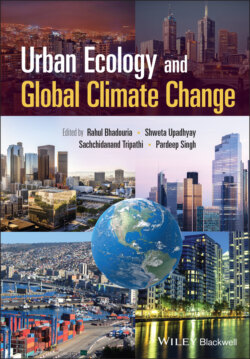Читать книгу Urban Ecology and Global Climate Change - Группа авторов - Страница 30
1.5.3.1 Green Space Development
ОглавлениеUrban greening programmes are the leading features of the policies related to the climate change mitigation (Weissert et al. 2014). In view of ongoing climate change, potential research and management emphasis has been given to identifying the impacts of socio‐demographic and environmental drivers on green spaces and the benefits derived from their conservation (Niemelä 2014; Verma et al. 2020c). The key tangible ecosystem services derived from the green spaces include mitigation of air pollution and UHI effect as well as physical and physiological health benefits to the residents (Verma et al. 2020b; Wang et al. 2020). Cooling effect provided by the green spaces is the most important ecosystem service which helps in mitigating UHI effect (Yu et al. 2017). The cooling effect of green spaces has been extensively explored by several researchers which involve two eco‐physiological mechanisms viz. evapotranspiration and shadowing (Jiao et al. 2017; Wang et al. 2020). Size and characteristics (shape, structure, and composition/configuration) of green space is more important for cooling effect as it increases with increasing size of the green spaces (Jaganmohan et al. 2016; Yu et al. 2017); however, it is still controversial and several other factors come into the play (Monteiro et al. 2016). However, there is a threshold value of efficiency (TVoE) above which increase in vegetation cover may not lead to a consequent decrease in land surface temperature (Bao et al. 2016; Yu et al. 2017). Tree‐based green spaces showed the highest cooling effect followed by bush and grassland (Kong et al. 2014). Since the canopy size and structure vary with the tree species, they provide different wind speed patterns which resulted in variable cooling effects (Armson et al. 2012). In addition, different trees have different eco‐physiological mechanisms (e.g. evapotranspiration and leaf area index) which depend on the resource availability and management practices (Wang et al. 2020). Kuang et al. (2015) observed a positive correlation between the cooling effect of green space and normalised difference vegetation index (NDVI). In addition, the presence of water bodies along with the green spaces improve the cooling effect. For example, green spaces connected with water bodies showed higher cooling effect, whereas grassland‐based green spaces showed weak cooling effect (Yang et al. 2020). Therefore, for climate change mitigation, interconnected green space and water body conservation and development are strongly suggested (Yu et al. 2017).
The magnitude of reduction of the temperature by one unit with the increase in vegetation (tree) cover is known as cooling efficiency (CE) which varies with the size and shape of the green spaces (Zhou et al. 2017; Wang et al. 2020). Compact green spaces with circular or square shapes provide more CE (Yu et al. 2017). Moreover, the regional climatic conditions also play a major role in shaping the vegetation structure and composition, thus, affecting CE (Richards et al. 2019). An extensive study was conducted by Wang et al. (2020) for 118 cities from 10 different biomes for observing the variation in CE. They used ordinary least squares (OLS) linear regression models with the percent of tree (Ptree) as independent variable and land surface temperature as dependent variable. They found the variation in CE from 0.04 to 0.57 °C with an average value of 0.17 °C where Ptree explained the 40.3% of the variation in the land surface temperature. Moreover, they observed that the biomes dominated by broadleaved trees reflect higher CE as compared to the biomes dominated by coniferous or sparse trees (e.g. savannas and shrublands). In addition to the inter‐city variations, intra‐city variations in CE were also observed, depending on the social and ecological contexts (Myint et al. 2015). Moreover, cities with hot and dry conditions (Mediterranean and desert biomes, e.g. Phoenix and Las Vegas) showed higher CE (Myint et al. 2015), whereas cities with hot and humid conditions (e.g. Nanjing, Beijing, Shenzhen, and Baltimore) reflected lower CE (Zhou et al. 2017). Exploring such scenarios for different cities from the developing and/or tropical nations could further help in mitigating UHI effects and adaptation to the climate change (Wang et al. 2020).
In addition to the direct reduction in land surface temperature, urban vegetation/tree shading also reduces the CO2 emissions from the buildings by cutting air‐conditioning costs during different weather conditions (Asgarian et al. 2015; Niemelä 2014). Moreover, visiting green space provides several benefits to the human in terms of health and well‐being; however, there is no conclusive research on the mechanism underlying such results (Wu 2013). Therefore, there is a need for interdisciplinary researchers including the sociologists, psychologists, public health practitioners, anthropologists, and the ecologists to explore the mechanisms behind the linkages between human health and green spaces (Tzoulas and Greening 2011). Further, planning and management of green spaces of an area have been influenced by several factors including from the personal/resident/owner level to the government and political levels which determine the type and size of vegetation (Niemelä 2014). Urban green spaces in cities are needed to plan in such a way that they can contribute to the climate change mitigation, by integrating and planting trees having optimal evapotranspiration potential and physical shading (Niemelä 2014; Vasishth 2015).
